Caviar

Caviar, sometimes called black caviar, is a luxury delicacy, consisting of processed, salted, non-fertilized sturgeon roe.[1] The roe can be "fresh" (non-pasteurized) or pasteurized, the latter having much less gastronomic and economic value.[2]
Traditionally the designation caviar is only used for sturgeon roe from the wild sturgeon species living in the Caspian Sea, in most cases from Azerbaijan, Russia or Iran (Beluga, Ossetra and Sevruga caviars). These caviar varieties, according to their quality (based on flavour, size, consistency and colour) can reach (February 2009) prices between € 6,000 and € 12,000 per kilo, and are associated with gourmet and Haute cuisine environments.
Depending on specific national laws, the name caviar may also be used by a variety of less expensive products, substitutes and imitations of caviar such as salmon roe (sometimes called red caviar), trout roe, lumpfish roe, etc.
However, according to the Food and Agriculture Organization, roe from any fish not belonging to the Acipenseriformes species (including Acipenseridae, or sturgeon stricto sensu, and Polyodontidae or paddlefish) are not caviar, but "substitutes of caviar".[3] This position is also adopted by the Convention on International Trade in Endangered Species of Wild Fauna and Flora,[4] the World Wide Fund for Nature,[5] the United States Customs Service,[6] and the Republic of France.[7]
Caviar is commercially marketed worldwide as a delicacy and is eaten as a garnish or a spread; for example, with hors d'œuvres.
Contents |
Varieties
.jpg)
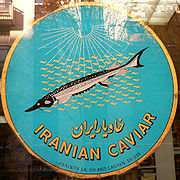
Caviar is simply sieved and lightly salted fish roe (eggs). Sturgeon roe is premium and considered the "true" caviar. The four main types of caviar are beluga, sterlet, osetra, and sevruga. The rarest and costliest is from the beluga sturgeon that swim in the Caspian Sea, which is bordered by Azerbaijan, Iran, Russia and other ex-Soviet republics. Wild caviar production has now survived only in Azerbaijan and Iran as Russia maintains a self-imposed ban on caviar trade from wild sturgeon.[8] Beluga caviar is prized for its soft, extremely large (pea-size) eggs. It can range in color from pale silver-gray to black. It is followed by the small golden sterlet caviar which is rare and was once reserved for Russian czars, Iranian shahs and Austrian emperors. Next in quality is the medium-sized, gray to brownish osetra (ossetra), and the last in the quality ranking is smaller, gray sevruga caviar.
Caviar bearing the word malossol on its label indicates that the roe is preserved with a minimum amount of salt, malossol being the Russian for "little salt." Caviar is extremely perishable and must be refrigerated immediately until consumption. Pasteurized caviar is roe that has been partially cooked, thereby giving the eggs a slightly different texture. It is less perishable and may not require refrigeration before opening. Pressed caviar is composed of damaged or fragile eggs and can be a combination of several different roes. It is specially treated, salted, and pressed. Information on how to handle purchased caviar can be found on the label. Although a spoonful of caviar supplies the adult daily requirement of vitamin B-12 it is also high in cholesterol and salt. The caviar of the sturgeon is the most expensive. Currently, dwindling fishing yields as a result of overfishing and pollution have resulted in the creation of less costly, though popular, caviar-quality roe alternatives from the whitefish and the North Atlantic salmon. The harvest and sale of black caviar (other than for use in scientific research) was banned in Russia in 2007 but resumed in 2010 (see below). Other popular and much less expensive types of roe, sometimes presented as caviar, include lumpfish caviar (tiny, hard, black eggs, whitefish caviar (also called American Golden) with its small yellow-gold eggs and salmon or red caviar (medium-size, pale orange to deep red eggs).
Ecology
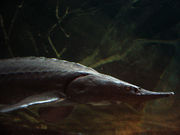
In the early 1900s, Canada and the United States were the major caviar suppliers to Europe; they harvested roe from the lake sturgeon in the North American midwest, and from the Shortnose sturgeon and the Atlantic sturgeon spawning in the rivers of the Eastern coast of the United States. Today the Shortnose sturgeon is rated Vulnerable in the IUCN Red List of endangered species and rated Endangered per the U.S. Endangered Species Act.
In Spain a fish farm called Caviar de Riofrio has begun to produce organic caviar. The company raises sturgeon in such a way that it has earned an organic certification.[9]
Current aquaculture of sturgeon is an economically viable means of sustainable, commercial caviar production, especially in Spain, France, Uruguay, and California.[10] Hackleback caviar is a popular, inexpensive product of this industry. Paddlefish, a sturgeon cousin, is also farmed in increasing numbers.
Recently, the amount of allowed wild fish harvesting has been decreased, consequently increasing caviar prices. In September 2005, the United States Fish and Wildlife Service banned the import of Caspian Sea Beluga caviar, to protect the endangered Beluga sturgeon; a month later, the ban included Beluga caviar from the entire Black Sea basin. In January 2006, CITES, the convention for trade in endangered species, announced they were "unable to approve the [caviar] export quotas" for 2006 from wild fish stocks.[11] In January 2007, this ban was partly lifted, allowing the sale of 96 tons of caviar, 15% below the official 2005 level.[12] In July 2010 Russia and some other CIS countries agreed to restart the export of caviar.[13] The 2010 quotas allow for the export of three tonnes of beluga, 17 tonnes of sevruga and 27 tonnes of osetra.[13]
The Caspian Sea produces 90 percent of the world's caviar. Over-fishing and smuggling as well as pollution caused by sewage entry into the Caspian Sea have considerably reduced the sea's sturgeon population.[14]
Production
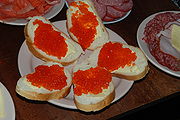
Commercial caviar production historically involved stunning the fish (usually by clubbing its head) and extracting the ovaries.
Nowadays most commercial fish farmers extract the caviar from the sturgeon surgically (compare caesarean section) and then stitch up the wound to keep the sturgeon alive, allowing the females to continue producing more roe during their lives.
Other farmers use a process called "stripping", which extracts the caviar from the fish without surgical intervention. [15] This is the most humane approach towards fish that is presently available but not all farmers use its due to the lack of knowledge in this field [16]
Iran is the world's largest producer and exporter of caviar (annual exports of more than 300 metric tons), followed by Russia.[17][18]
Alternatives and imitation
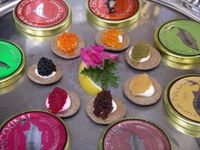

In Scandinavia, a significantly cheaper version of caviar, made from mashed and smoked cod roe (smörgåskaviar or sandwich caviar), is sold in tubes as a sandwich filling. When sold outside Scandinavia, the product is referred to as creamed smoked roe or in French as Caviar de Lysekil, named after the Swedish coastal town of Lysekil from which this type of caviar may have originated.
An obvious sturgeon caviar imitation is Danish or German black coloured lumpsucker caviar, which is sold throughout Europe in small glass jars. It can also be found coloured red. A more expensive sturgeon caviar alternative sold in Sweden and Finland is caviar from the vendace. In Finland caviars from the burbot and the common whitefish are also sold.
In some eastern European countries, such as Ukraine and Russia, "Ikra" also refers to an eggplant or squash spread which is often referred to as "poor man's caviar."
Caviar farms have also been established in the mountains of Spain.
In the vegetarian foodstuffs market, algae-based imitation caviar is produced and sold as a caviar alternative.
Cultural
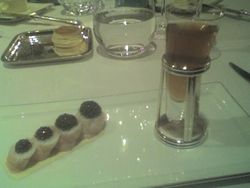
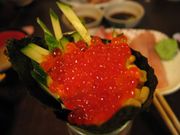
Given its high price in the West, caviar is associated with luxury and wealth. In Russia and other Eastern European cultures, though still expensive, caviar is commonly served at holiday feasts, weddings, and other festive occasions.
Sturgeon-derived caviar is not eaten by Kosher observant Orthodox Jews because sturgeon lack the scales mandated by the kosher diet. Sturgeon possess ganoid scales instead of the permitted ctenoid and cycloid scales. Although there is a discussion of its status within Halacha, since the scales will come off if soaked in lye; however, this does not apply to every roe-yielding fish species. Kosher-observant Conservative Jews, on the other hand, may or may not observe these rules, as the responsa are not clear on this point.
In Islam generally all sea or river animals such as fish are lawful and halal which applies to the sturgeon as well as its caviar.
In East Asia, "caviar" made from caplin roe may be found on sushi and is often very affordable. Salmon roe is called "ikura" in Japanese, a derivative of the Russian, "ikra" (caviar).
Caviar is also seen as a common offering to the feline species in the ancient Egyptian Bast cult.
References
- ↑ Houshang Alʿam, "Caviar", in Encyclopædia Iranica online.
- ↑ According to Jean-Pierre Esmilaire, Directeur Général of Caviar House & Prunier: "two-thirds of caviar's taste is lost through pasteurisation." (in "Three-star caviar", Caterersearch - The complete information source for hospitality, 01 February 2001). Also Judith C. Sutton states that "pasteurized caviar doesn't taste as good or have the consistency of fresh caviar, and cviar lovers avoid it." ( in Judith C. Sutton, Champagne & Caviar & Other Delicacies, New York, Balck Dog & Leventhal, 1998, p. 53.)
- ↑ "Roe coming from a fish other than Acipenseriformes is not caviar, and is often classified as «caviar substitute»." in Catarci, Camillo (2004), "Sturgeons (Acipenseriformes)", in World markets and industry of selected commercially-exploited aquatic species with an international conservation profile, FAO Fisheries Circulars - C990, FAO Corporate Document Repository, Fisheries and Aquaculture Department.
- ↑ "Caviar: processed roe of Acipenseriformes species." in CITES (2002), "Annex 1 - CITES guidelines for a universal labelling system for the trade in and identification of caviar", in Resolution Conf. 12.7 - Conservation of and trade in sturgeons and paddlefish, Twelfth meeting of the Conference of the Parties, Santiago (Chile), 3-15 November 2002.
- ↑ "Caviar is made from the unfertilized eggs of female sturgeon and paddlefish, among the oldest and largest species of fish living on earth." in World Wide Fund for Nature, Wildlife Trade - Caviar Trade FAQs.
- ↑ "The United States of America Custom Service (US Customs & Border Protection, 2004) defines caviar thus: Caviar is the eggs or roe of sturgeon preserved with salt. It is prepared by removing the egg masses from freshly caught fish and passing them carefully through a fine-mesh screen to separate the eggs and remove extraneous bits of tissue and fat. At the same time, 4–6 percent salt is added to preserve the eggs and bring out the flavour. Most caviar is produced in Azerbaijan, Russia and Iran from fish taken from the Caspian Sea, the Black Sea, and the Sea of Azov." in Johannesson, J. (2006), "1. Fish roe products and relevant resources for the industry: Definitions of caviar", Lumpfish caviar – from vessel to consumer, FAO Fisheries Technical Paper No. 485, Rome, FAO, p.1.
- ↑ Arrêté du 23 février 2007 (NOR: DEVN0750874A; Version consolidée au 06 mai 2007), Article 1: "a) Caviar : oeufs non fécondés, traités, des espèces d'acipensériformes dont la liste figure en annexe du présent arrêté;".
- ↑ [1] – Russia has maintained a ban on the international export of sturgeon roe
- ↑ www.boston.com - More than one fish egg in the sea
- ↑ California Farm Bureau Federation - Farmers tame prehistoric fish to make food fit for a king
- ↑ news.bbc.co.uk - International caviar trade banned
- ↑ news.bbc.co.uk - UN lifts embargo on caviar trade
- ↑ 13.0 13.1 "Caviar producers to restart wild caviar exports". July 25 2010. http://www.telegraph.co.uk/news/worldnews/asia/kazakhstan/7908643/Caviar-producers-to-restart-wild-caviar-exports.html. Retrieved July 2010.
- ↑ http://www.presstv.com/detail.aspx?id=136154§ionid=351020102
- ↑ [2] – The link to the Latvian farm which pioneered commercial “stripping” in 2007
- ↑ [3] – The article in the Independent newspaper 24 September 2009
- ↑ "Crunch time for Caspian caviar". BBC News. 2001-06-19. http://news.bbc.co.uk/2/hi/business/1394717.stm. Retrieved 2010-04-28.
- ↑ http://www.art-arena.com/land.htm
External links
- How To Serve Caviar
- Cooking For Engineers: Caviar
- Stolt Sea Farm
- Sturgeon population in Hudson River - Once-Endangered Sturgeon Rebounding in Hudson River, Study Says
- Caspian caviar in peril
|
|||||||